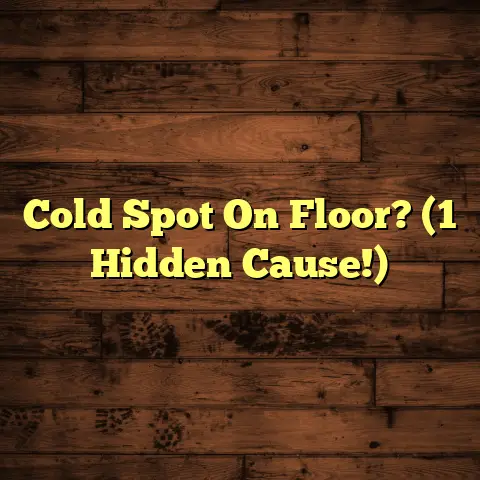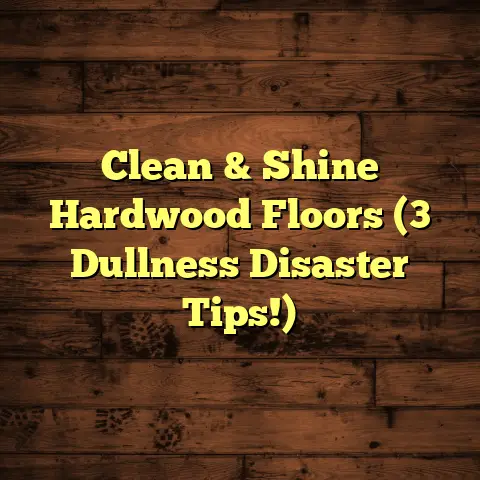Fix Basement Floor Seepage Fast! (9 Tips)
I’m not just talking about a cozy couch or the perfect temperature.
Real comfort in your home starts with a solid foundation – literally!
A dry, secure basement is essential for a comfortable living environment.
Think about it: your basement impacts air quality, humidity, and even the structural integrity of your entire house.
Basement floor seepage?
That’s a comfort killer.
It can lead to mold, nasty odors, and some serious structural damage.
Trust me, I’ve seen it all in my years as a flooring contractor.
But don’t worry! I’m here to help.
These tips are actionable solutions to fix basement floor seepage fast.
We’re talking about creating a safe, comfortable home you can truly enjoy.
Let’s dive in!
9 Tips to Fix Basement Floor Seepage Fast
1. Identify the Source of Seepage
Okay, Sherlock Holmes, time to put on your detective hat!
The first step is figuring out where the water is coming from.
Is it poor drainage? Cracks in the foundation? High groundwater levels?
These are all common culprits.
I always tell my clients, “You can’t fix a problem if you don’t know what’s causing it.”
So, how do you inspect?
-
Visual Inspection: Carefully walk around your basement, looking for any signs of moisture. Check the walls, floor, and corners. Are there any wet spots, stains, or discoloration?
-
Check the Perimeter: Go outside and inspect the foundation. Look for cracks, especially near ground level.
-
Observe After Rain: Pay close attention to your basement after a heavy rain. This is when seepage is most likely to occur.
-
Consider Gutters and Downspouts: Are they directing water away from your foundation?
-
Check for Condensation: Sometimes, what looks like seepage is actually condensation. Place a square of plastic wrap on the floor and tape down the edges. After 24 hours, check the plastic. If moisture is on top, it’s condensation. If it’s underneath, it’s seepage.
Take notes, snap some pictures, and be thorough.
The more information you gather, the easier it will be to diagnose the problem.
2. Improve Gutters and Downspouts
Proper drainage is your first line of defense against basement seepage.
Think of your gutters and downspouts as a water management system.
If they’re clogged, damaged, or poorly positioned, water will end up pooling around your foundation.
And guess where that water goes?
Yup, right into your basement.
Here’s what you need to do:
-
Clean Your Gutters Regularly: I recommend cleaning your gutters at least twice a year – in the spring and fall. Remove leaves, twigs, and other debris that can clog them up.
- Safety First! Use a sturdy ladder and wear gloves. You can also hire a professional gutter cleaning service.
-
Extend Your Downspouts: Downspouts should direct water at least 6 feet away from your foundation. You can buy downspout extensions at any hardware store.
-
Check for Damage: Inspect your gutters and downspouts for cracks, leaks, or sagging. Repair or replace them as needed.
-
Ensure Proper Slope: Gutters should slope slightly towards the downspouts to ensure proper drainage.
-
Consider Gutter Guards: Gutter guards can help prevent debris from clogging your gutters in the first place.
I cannot overstate this, proper water management is key.
3. Grade the Landscape
Grading refers to the slope of the land around your foundation.
Ideally, the land should slope away from your house.
This helps to direct rainwater away from your foundation, preventing it from seeping into your basement.
If the land slopes towards your house, water will naturally flow towards your foundation.
And that’s a recipe for disaster.
Here’s how to evaluate and modify your landscape:
-
Observe After Rain: Pay attention to where water pools after a heavy rain. Does it pool near your foundation?
-
Check the Slope: Use a level and a long board to check the slope of the land around your foundation. It should slope away from the house at a rate of at least 6 inches over 10 feet.
-
Add Soil: If the land slopes towards your house, you’ll need to add soil to create a positive slope. Use a shovel and a wheelbarrow to move soil away from the foundation.
-
Compact the Soil: After adding soil, compact it firmly to prevent erosion.
-
Consider Drainage Solutions: If you have a particularly severe grading problem, you may need to install a French drain or other drainage solution.
Grading is often overlooked, but it can make a huge difference.
4. Install a Sump Pump
A sump pump is a proactive measure against basement seepage.
It’s basically a pump that sits in a pit in your basement floor.
When water levels rise, the pump automatically kicks on and pumps the water away from your foundation.
Sump pumps are particularly useful in areas with high groundwater levels or frequent flooding.
Here’s what you need to know about sump pumps:
-
Choose the Right Pump: Sump pumps come in different sizes and with different features. Choose one that’s appropriate for the size of your basement and the amount of water you expect to pump.
-
Consider a Battery Backup: Power outages can happen during heavy rains, when you need your sump pump the most. A battery backup will keep your pump running even when the power is out.
-
Install the Pump Properly: Follow the manufacturer’s instructions carefully when installing your sump pump. Make sure the pump is level and the discharge pipe is properly connected.
-
Maintain Your Pump: Sump pumps require regular maintenance to keep them running smoothly. Clean the pump and the pit regularly, and check the discharge pipe for clogs.
-
Test Your Pump Regularly: Test your sump pump at least once a year to make sure it’s working properly. You can do this by pouring water into the pit until the pump kicks on.
Sump pumps are a great investment.
5. Apply Waterproofing Sealants
Waterproofing sealants can help to prevent water from seeping through your basement floor.
There are a variety of sealants available, including:
-
Concrete Sealers: These sealants penetrate the concrete and create a waterproof barrier.
-
Waterproof Paint: This paint is specifically designed to repel water.
-
Epoxy Coatings: Epoxy coatings create a durable, waterproof surface.
When choosing a sealant, consider:
-
The Severity of Seepage: If you have severe seepage, you’ll need a more robust sealant.
-
The Type of Flooring: Some sealants are not compatible with certain types of flooring.
-
The Ease of Application: Some sealants are easier to apply than others.
Before applying a sealant, clean the floor thoroughly and repair any cracks.
Follow the manufacturer’s instructions carefully when applying the sealant.
6. Repair Cracks in the Foundation
Cracks in your foundation are like open invitations for water to enter your basement.
Even small cracks can allow a surprising amount of water to seep through.
That’s why it’s so important to address any visible cracks as soon as possible.
Here’s how to repair foundation cracks:
-
Assess the Crack: Determine the size, depth, and location of the crack.
-
Clean the Crack: Use a wire brush to remove any loose debris from the crack.
-
Widen the Crack (If Necessary): For larger cracks, you may need to widen them slightly to allow for better adhesion of the repair material.
-
Apply a Crack Repair Product: There are a variety of crack repair products available, including epoxy injections, hydraulic cement, and polyurethane sealants. Choose a product that’s appropriate for the size and type of crack.
-
Follow the Manufacturer’s Instructions: Apply the crack repair product according to the manufacturer’s instructions.
-
Allow to Cure: Allow the repair material to cure completely before exposing it to water.
I’ve seen clients put this off and the problem gets 10x worse.
7. Use a Dehumidifier
Humidity can exacerbate basement seepage and contribute to mold growth.
A dehumidifier removes excess moisture from the air, helping to keep your basement dry and comfortable.
Here’s what you need to know about dehumidifiers:
-
Choose the Right Size: Dehumidifiers are rated by the amount of moisture they can remove per day. Choose a size that’s appropriate for the size of your basement.
-
Place the Dehumidifier Properly: Place the dehumidifier in a central location in your basement.
-
Maintain Optimal Humidity Levels: Aim for a humidity level of 30-50%.
-
Empty the Water Tank Regularly: Dehumidifiers collect water in a tank that needs to be emptied regularly.
-
Clean the Filter Regularly: Clean the filter regularly to ensure that the dehumidifier is running efficiently.
A dehumidifier is a simple way to improve your basement’s comfort.
8. Install Interior Drainage Systems
Interior drainage systems collect and redirect water away from your basement floor.
These systems typically consist of a perforated pipe that’s installed around the perimeter of your basement floor.
The pipe collects water that seeps through the walls and floor, and then directs it to a sump pump.
The sump pump then pumps the water away from your foundation.
Interior drainage systems are a more comprehensive solution for basement seepage.
Here’s what you need to know:
-
Installation Process: The installation process typically involves cutting a trench around the perimeter of your basement floor, installing the perforated pipe, and then covering the pipe with gravel and concrete.
-
Costs: The cost of installing an interior drainage system can vary depending on the size of your basement and the complexity of the installation.
-
DIY vs. Professional: You can install an interior drainage system yourself, but it’s a challenging project. If you’re not comfortable with DIY projects, it’s best to hire a professional.
9. Consider Exterior Waterproofing Solutions
Exterior waterproofing solutions are the most extensive way to prevent basement seepage.
These solutions involve excavating around your foundation and applying a waterproof membrane to the exterior walls.
Exterior waterproofing is typically only necessary in cases of severe seepage or when other solutions have failed.
Here’s what you need to know:
-
Excavation: The excavation process involves digging around your foundation to expose the exterior walls.
-
Waterproof Membrane: A waterproof membrane is then applied to the exterior walls to prevent water from seeping through.
-
Backfilling: After the membrane is applied, the excavation is backfilled with soil.
-
Costs: Exterior waterproofing is the most expensive solution for basement seepage.
-
Benefits: Exterior waterproofing is the most effective way to prevent basement seepage.
Exterior waterproofing is a big undertaking.
Conclusion: Take Action for a Comfortable Home
Basement floor seepage is a serious problem that can compromise the comfort and safety of your home.
But don’t despair! By taking action and implementing these tips, you can fix basement floor seepage fast and create a comfortable, dry, and healthy living environment.
Remember, a dry basement is essential for a healthy home.
So, take action today and protect your investment!
You’ve got this!





